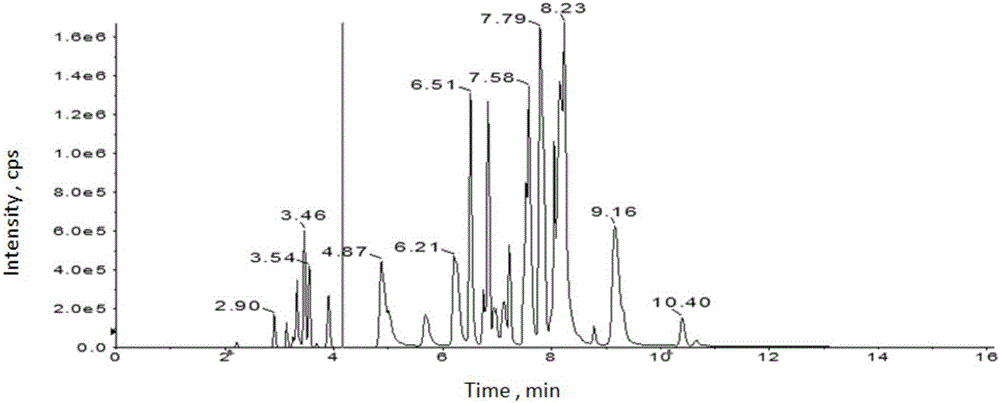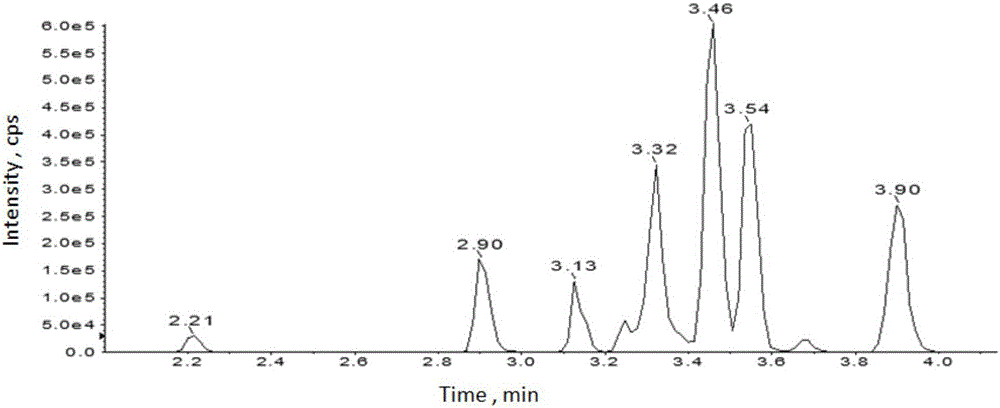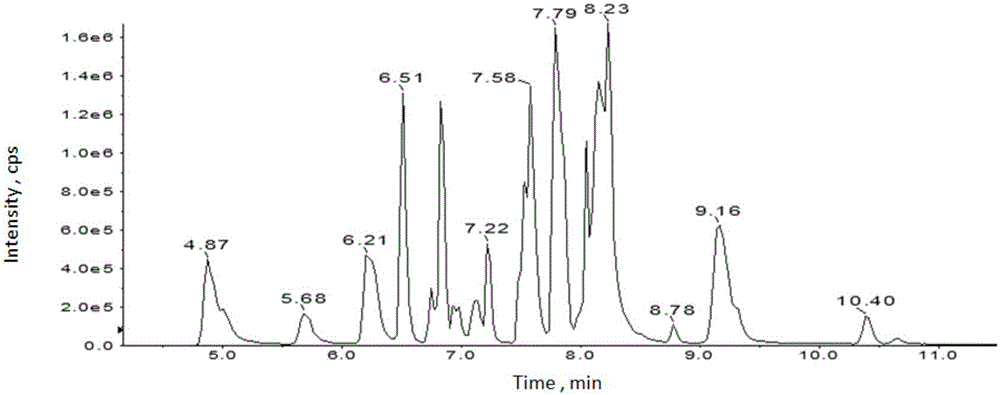Method for detecting pigment in flavouring
A detection method and condiment technology, which is applied in the direction of measuring devices, instruments, scientific instruments, etc., can solve the problems of complex processing process, time-consuming, single detection mode, etc., and achieve high sensitivity, low cost, and good purification effect.
- Summary
- Abstract
- Description
- Claims
- Application Information
AI Technical Summary
Problems solved by technology
Method used
Image
Examples
Embodiment 1
[0044] An embodiment of the detection method of the pigment in the condiment of the present invention, the condiment of this embodiment is a kind of seasoning sauce, the method described in this embodiment comprises the following steps:
[0045] (1) Pigment extraction
[0046] Weigh 2g of sample into a 50mL centrifuge tube, add 5mL extractant, and vortex to mix evenly; the extractant is mixed with acetonitrile and methanol at a volume ratio of 50:50; centrifuge the centrifuge tube at 4500r / min for 5min, and recover the supernatant ; Repeat the extraction once, and combine the extracts.
[0047] (2) Purification of extract by QuEChERS method
[0048] Take 1mL extract in a 2mL centrifuge tube, add 25mg C 18 Adsorbent, vortexed for 1min, centrifuged at 8000r / min for 2min. Take 0.3mL supernatant, dilute to 1mL with water, pass through a 0.22μm polytetrafluoroethylene filter membrane, and wait for determination.
[0049] (3) UPLC-MS / MS analysis
[0050] Chromatographic column:...
Embodiment 2
[0074] An embodiment of the detection method of the pigment in the condiment of the present invention, the condiment of this embodiment is a kind of seasoning sauce, the method described in this embodiment comprises the following steps:
[0075] (1) Pigment extraction
[0076] Weigh 2g of sample into a 50mL centrifuge tube, add 5mL extractant, and vortex to mix evenly; the extractant is mixed with acetonitrile and methanol at a volume ratio of 50:50; centrifuge the centrifuge tube at 4500r / min for 5min, and recover the supernatant ; Repeat the extraction once, and combine the extracts.
[0077] (2) Purification of extract by QuEChERS method
[0078] Take 1mL extract in a 2mL centrifuge tube, add 25mg C 18 Adsorbent, vortexed for 1min, centrifuged at 8000r / min for 2min. Take 0.3mL supernatant, dilute to 1mL with water, pass through a 0.22μm polytetrafluoroethylene filter membrane, and wait for determination.
[0079] (3) UPLC-MS / MS analysis
[0080] Chromatographic column:...
Embodiment 3
[0099] An embodiment of the detection method of the pigment in the condiment of the present invention, the condiment of this embodiment is a kind of seasoning sauce, the method described in this embodiment comprises the following steps:
[0100] (1) Pigment extraction
[0101] Weigh 2g of sample into a 50mL centrifuge tube, add 5mL extractant, and vortex to mix evenly; the extractant is a mixture of acetonitrile and methanol, wherein the volume percentage of acetonitrile is 20%; centrifuge the centrifuge tube at 4500r / min for 5min , recover the supernatant; repeat the extraction once, and combine the extracts.
[0102] (2) Purification of extract by QuEChERS method
[0103] Take 1mL extract in a 2mL centrifuge tube, add 25mg C 18 Adsorbent, vortexed for 1min, centrifuged at 8000r / min for 2min. Take 0.2mL supernatant, dilute it with water to 0.7mL, pass through a 0.22μm polytetrafluoroethylene filter membrane, and wait for determination.
[0104] (3) UPLC-MS / MS analysis
...
PUM
 Login to View More
Login to View More Abstract
Description
Claims
Application Information
 Login to View More
Login to View More - R&D
- Intellectual Property
- Life Sciences
- Materials
- Tech Scout
- Unparalleled Data Quality
- Higher Quality Content
- 60% Fewer Hallucinations
Browse by: Latest US Patents, China's latest patents, Technical Efficacy Thesaurus, Application Domain, Technology Topic, Popular Technical Reports.
© 2025 PatSnap. All rights reserved.Legal|Privacy policy|Modern Slavery Act Transparency Statement|Sitemap|About US| Contact US: help@patsnap.com



